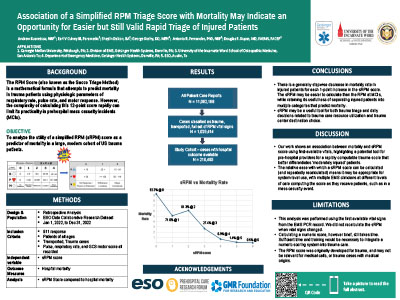ABSTRACTS
Association of a Simplified RPM Triage Score with Mortality May Indicate an Opportunity for Easier but Still Valid Rapid Triage of Injured PatientsAuthor: Andrew Kuznetsov | | Associate Authors: Andrew Kuznetsov NRP, Earl V Culvey III NRP, Shaylin Dalton BA, George Koshy DO MPH, Antonio R Fernandez PhD NRP Douglas F Kupas MD FAEMS FACEP
Introduction: The RPM score (also reported as the Sacco Triage Method) is a mathematical model used in resource-constrained trauma triage situations to identify patients that should be prioritized for transport by EMS. The score is calculated using respiratory rate, pulse rate, and motor response. It provides a 12-point score that has been associated with mortality in several studies. However, its complexity can limit its practicality in prehospital mass casualty incidents (MCIs). Objective: The purpose of this study is to develop a simplified RPM score (sRPM) and validate its association with mortality in trauma patients. Methods: This retrospective study analyzed prehospital and hospital data from the ESO Data Collaborative 2022 from January 1, 2022 to December 31, 2022. The study included all 9-1-1 responses for patients who were transported and classified as trauma. The RPM score was simplified apriori by combining its 0-4 scale for each physiologic measurement to generate a 0-2 point scale that ranges from 0-6 when totaled for all three measures. The sRPM score was calculated using the first available prehospital values for respiratory rate, heart rate, and motor score. Pre-hospital deaths, interfacility transports, and canceled calls were excluded. The primary outcome measure is mortality at the receiving hospital. Descriptive statistics were calculated. Results: During the study period, there were 1,025,414 911 responses for patients that were transported and classified as trauma. Of these, 219,495 (21.4%) patients had hospital outcome data available. The mortality rate associated with each level of sRPM score is: 0=92.3%; 1=71.6%; 2=61.3%; 3=27.4%, 4=6.9%; 5=1.4%; 6=0.5%. An RPM > 4 was associated with a low percentage of mortality, cumulatively only 1.9%. Conclusion: There was a stepwise decrease in percent mortality in injured patients for each 1-point increase in the sRPM score. The sRPM may be easier to calculate than the RPM at MCIs, while retaining its usefulness of separating injured patients into multiple categories that predict mortality. sRPM may be a useful tool for both trauma triage and daily decisions related to trauma care resource utilization and trauma center destination choice.
|

